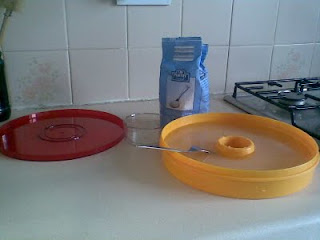You know your blog is a success when you start to get complaints. Yes, I'm proud to say I have my first whinging email from a friend in Dubai, demanding the next instalment in the story of my bees :)
So here it is folks:
Firstly, the human beekeeper networking continues; we had our Association Christmas Party which was a fabulous evening of games and great food. I think I threw my name away (again) when I leapt up during the game of "Rat" yelling "Mistrial, I declare a mistrial!" which was really inappropriate because how can you have a mistrial when all you have to do is hit a sock with a stick? All I can say in my own defence, Your Honour, is that it was just the first word that sprang to mind. I blame it on the two glasses of red wine and my gigantic slice of Ron's Giant Fruit Cake, I do.
It was at the Christmas Party that the subject of Bee Food was raised. I had realised that bees get candy for Christmas and I had spent a few laconic hours surfing the net in search of Baker's Fondant, without success. Well, let's just say - limited success. When you realise you're going to have to pay a fortune in postage for 12.5kg of the stuff, you tend to have to stop and think about it for a while. Which is where the subject lay untouched until the Party. The Committee has been great, and a plan was hatched with one of them, to buy in 1 amount of fondant, and split it among the Newbees.
And so it came to pass that I ended up in the passenger seat of The Great Blondini, making rude shapes with a great big 4kg block of white gelatinous substance wrapped in clingfilm on my lap, which can take on the warm feeling of - ooh, I dunno - large human appendages, to put it politely :) The fondant, not my lap.
Seeing that I would be required to pop the top off the hive to drop the fondant in place over the central hole in the crownboard, I decided to take the opportunity to fill the empty space around it in the super with insulation. I created insulation "cushions" using reflective thinsulate used to wrap pipes against freezing, and inside them I dropped large rough pieces of polystyrene before sealing them up and dropping them loosely into the super.
I wonder if it will work.
Of course, then came the Arctic Conditions.
It has snowed every day since Thursday. Yesterday morning, it hit -6 degrees in Finchley. Yes, that's a minus six. Conditions are harsh. We've had everything from 2 to 10 inches of snow on all exterior surfaces for the last week. We've had to dig ourselves out of snowbanks, ice sheets and powder every time we leave the house. Rations got low, but we loaded up on Mr Kipling's Mince Pies and lots of tinned custard and we don't intend to stop eating till the first thaw. (Hopefully, the bees are singing from the same song sheet in this regard.)
I nipped down to the hive at the start of the snow week on Thursday evening, and had to brush a thin layer of snow off the top. At the same time, I noticed the small piece of wood that's come loose on the crownboard has - curses of curses - worked free and left a small gap which no doubt is causing a cold draft into the hive. Bugger! I should've fixed it or placed the new crownboard on sooner.
What to do!? I decided I would leave it as is, considering I have a pile of insulation cushions and food on top of it right now. But I thought "let me seal it up with some thinsulate wrapping at least, to stop the draft". This took a bit of work around the perimeter of the hive and at one stage, I must've disturbed the bees. A bee shot out of the front entrance, clearly furious and zoomingly irate, only to hit the cold air with a noticable gasp, bounce off a tree and bowl over onto the ground, where she lay, breathless for a bit, before crawling up back into the hive. It was both tragic and hugely funny - because she so clearly came out furious and dived back in, freezing :)
I do hope she survived. I've discovered that bees can't survive the cold. Once they hit 8 degrees, they slowly become paralysed and if they're not rescued, will simply stay like that until they die.
So I've sealed up a side of the hive until it warms up again. I've also constructed a Bee Tent over the top of the hive. At first it was just a makeshift effort created one dark night after yet another two glasses of red wine, using Guy's army poncho. But on the weekend, I took a large tarpaulin folded over 4 or 5 times,and pegged it on to the Inconvenient Rope Between Two Trees and, at an angle, hammered nails into the bottom ends, thus creating a sort of angled roof to allow runoff of snow and rain. Amateurish, but functional, as I checked it later in the week and it's keeping the snow off and the temperature at least a degree higher underneath.
From now on, I don't think I can really go into the hive at all to check on their condition.
I really do just need to leave them be now.
All we can do now is pray!
Spare a thought for my bees over Christmas, gentle reader, spare a thought for all bees everywhere in the Northern Hemisphere.
Here's hoping they get their fill of candy and make it through their own Very Merry Christmas.
And here's wishing you all - from Dubai to Johannesburg, from Enfield to Aylesbury - A Very Merry Christmas too!




























